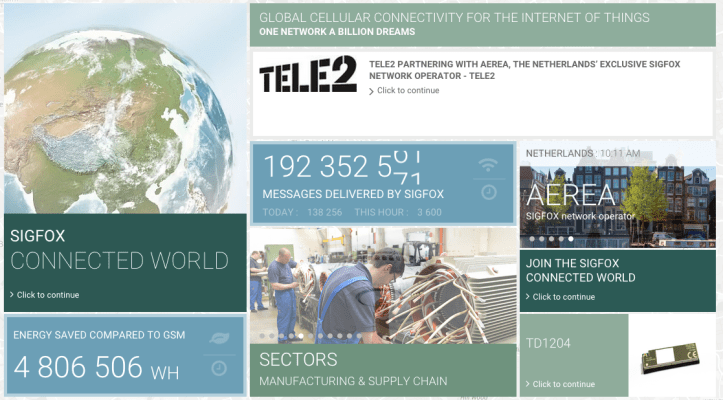Mobile carriers want to play a central role in the Internet of Things — as the glue that links up connected objects and lets them communicate with each other — and now they are funding a startup out of France that is making IoT networks a reality.
Sigfox — owner and operator of a low-energy, low-cost cellular network dedicated only to connected objects — today confirmed that it has raised a round of $115 million (€100 million). It plans to use the funding to build out its network across Europe, the U.S. and Asia.
Sigfox has already built out its network in France, Spain, the United Kingdom, the Netherlands and is working on deploying “soon” in the U.S.
Tellingly, the Series D round brings together a number of strategic investors including the Spanish, Korean and Japanese carriers Telefonica, SK Telecom and NTT DOCOMO (whose Ventures arm did the investing), and French industrial giants GDF SUEZ, Air Liquide and Eutelsat. Also participating was Elliott Management Corporation.
Previously, Sigfox had raised about €30 million from investors that include Intel Capital, Partech and several other French investors.
This looks to be one of the highest-ever rounds of funding for a French startup — a position that is somewhat skewed given the capex needed to build out cellular networks.
“This record $115 million round is a significant step in the development of our network’s coverage all around the world. The trust of our investors and the dynamism of SIGFOX’s team allow us to strengthen our position as the world leader in IoT communications,” said Anne Lauvergeon, SIGFOX’s chairman.
The move to invest a lot of money in Sigfox comes at an interesting moment for the company, and also for the IoT industry.
Large tech titans like Google have made no secret of their interest in developing more connected products for the home and beyond, and that’s before you consider the large number of consumer and industrial electronics companies that are also investing into this area, building not just connected hardware but also services to help them run.
While Google has (yet!) to make a play as the network provider for such services, carriers have long positioned themselves as the natural heirs to the job of running the network that would connect these objects — after all, they already have the data networks in place. In that context, Sigfox has been taking a different approach that throws carrier’s entitlement into some question.
The company’s network is built only to run data traffic for connected objects, and by architecting it this way, it’s calibrated to cover much larger geographies for much lower costs. Without the network strains of traditional cellular data traffic, Low-Power Wide-Area (LPWA) connectivity, as it is called, is significantly cheaper and easier to deploy and run than, for example, WCDMA deployments (the GSM-based 3G network format).
As a regular reminder of its purpose and superiority, on its homepage, Sigfox constantly updates how much energy it conserves compared to traditional GSM, while also tallying up how many “messages” are sent across its network (now approaching 192 million).
It looks like now, carriers and satellite companies are interested in joining Sigfox (or complementing it) rather than trying to beat it.
As for the industrial investors, it looks like GDF Suez and Air Liquide will be contributing some of its latest developments in energy management. Like many oil companies, it’s making a major effort to invest in alternative energy use partly out of social responsibility, but also partly because they must consider how they might diversify their businesses in the longer term.
“Sigfox’s technology and network, thanks to its significant deployment, perfectly suits our needs for a part of our ‘smart’ devices, especially in terms of energy efficiency for long-distance communication,” said a spokesperson from ALIAD, the corporate venture capital arm of Air Liquide.
